Locus (genetics)

(1) Chromatid
(2) Centromere
(3) Short (p) arm
(4) Long (q) arm
A locus (plural loci) in genetics is the position on a chromosome.[1] Each chromosome carries many genes; humans' estimated 'haploid' protein coding genes are 19,000-20,000,[2] on the 23 different chromosomes. A variant of the similar DNA sequence located at a given locus is called an allele. The ordered list of loci known for a particular genome is called a gene map. Gene mapping is the process of determining the locus for a particular biological trait.
Diploid and polyploid cells whose chromosomes have the same allele of a given gene at some locus are called homozygous with respect to that gene, while those that have different alleles of a given gene at a locus, are called the heterozygous with respect to that gene.[3]
Nomenclature

The chromosomal locus of a gene might be written 3p22.1, where
- 3 = chromosome 3
- p = p-arm (short arm)
- 22 = region 2, band 2 (read as "two, two", not "twenty-two)
- 1 = sub-band 1
Thus, the entire locus is read as "three P two two point one."
The cytogenetic bands are counting from the centromere out toward the telomeres.
| Component | Explanation |
| 3 | The chromosome number. |
| p | The position is on the chromosome's short arm (a common apocryphal explanation is that the p stands for petit in French); q indicates the long arm (chosen as next letter in alphabet after p; alternatively it is sometimes said that q stands for queue meaning tail in French). |
| 22.1 | The numbers that follow the letter represent the position on the arm: region 2, band 2, sub-band 1. The bands are visible under a microscope when chromosome is suitably stained. Each of the bands is numbered, beginning with 1 for the band nearest the centromere. Sub-bands and sub-sub-bands are visible at higher resolution. |

A range of loci is specified in a similar way. For example, the locus of gene OCA1 may be written "11q1.4-q2.1", meaning it is on the long arm of chromosome 11, somewhere in the range from sub-band 4 of region 1 to sub-band 1 of region 2.
The ends of a chromosome are labeled "pter" and "qter", and so "2qter" refers to the terminus of the long arm of chromosome 2.
Centisome
A centisome (not to be confused with a centrosome) is defined as 1% of a chromosome length.[4]
See also
- Chromosomal translocation
- Cytogenetic notation
- Karyotype
- Null allele
- International System for Human Cytogenetic Nomenclature
References
- ^ Wood, E.J. (1995). "The encyclopedia of molecular biology". Biochemical .Education. 23 (2): 1165. doi:10.1016/0307-4412(95)90659-2.
- ^ Ezkurdia, Iakes; Juan, David; Rodriguez, Jose Manuel; Frankish, Adam; Diekhans, Mark; Harrow, Jennifer; Vazquez, Jesus; Valencia, Alfonso; Tress, Michael L. (2014-11-15). "Multiple evidence strands suggest that there may be as few as 19,000 human protein-coding genes". Human Molecular Genetics. 23 (22): 5866–5878. doi:10.1093/hmg/ddu309. ISSN 1460-2083. PMC 4204768. PMID 24939910.
- ^ "NCI Dictionary of Genetics". National Cancer Institute. Retrieved 13 December 2014.
- ^ Peter D. Karp; Monica Riley (2009-01-11), Representations of Metabolic Knowledge (PDF)
Michael, R. Cummings. (2011). Human Heredity. Belmont, California: Brooks/Cole
